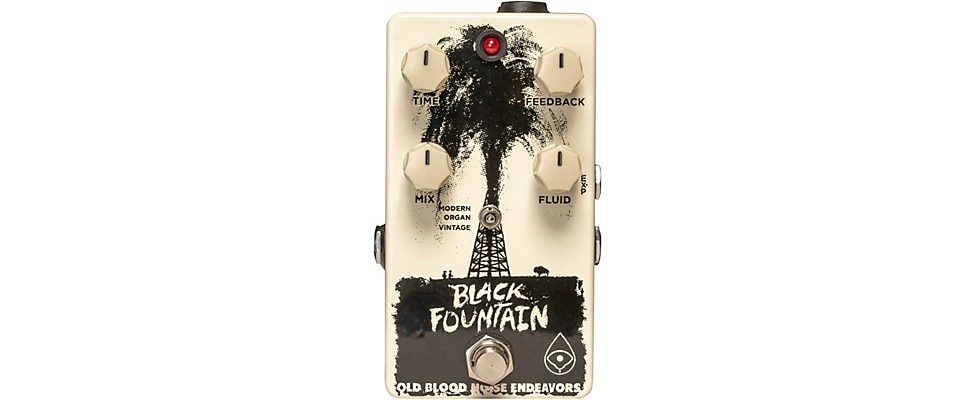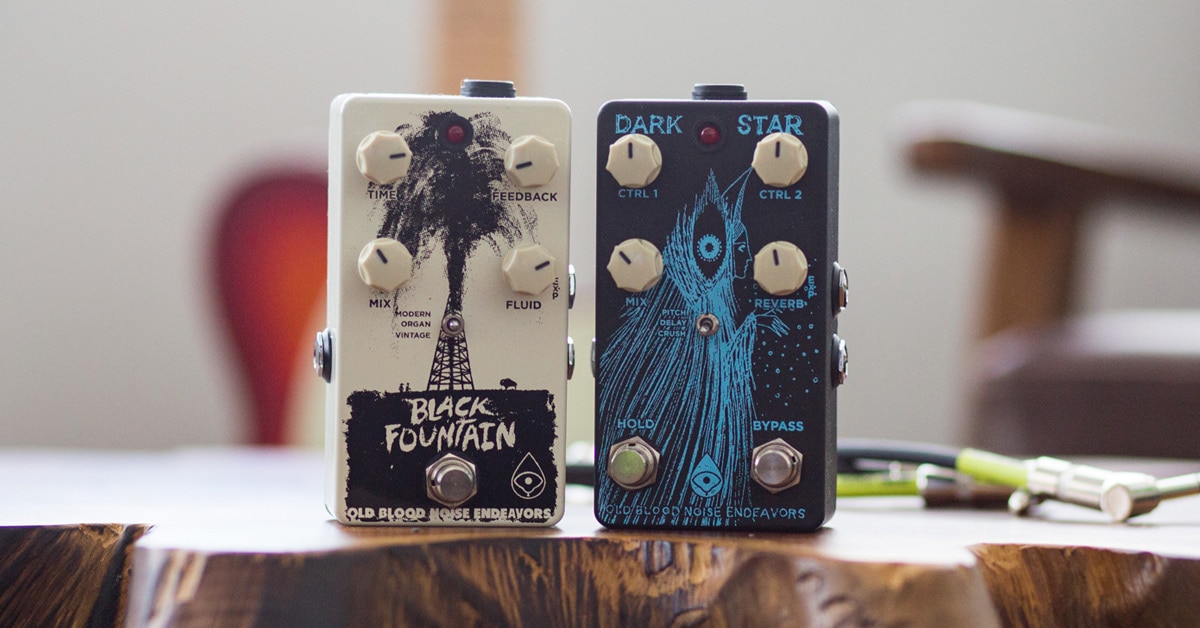Written by George Van Wagner, Musician's Friend Staff Writer
One of the group of talented pedal makers headquartered in and around Oklahoma City, Oklahoma, Old Blood Noise Endeavors, which will be referred to as OBNE for the rest of this review, has been making a serious name for themselves as a designer and producer of effects pedals that step off our shared reality to create a new sonic universe. Their pedals bend, twist and manipulate sound in some surprising, angular and extremely musical ways. I recently got to spend some time with a number of their pedals, thanks to Musician’s Friend. The two I’m going to talk about here—the Black Fountain and the Dark Star—both offer some unique features, and I was eager to take a closer look.
Black Fountain
Let’s start with the pedal that hews closest to “normalcy”—the Black Fountain. It’s a tribute to the old “oil can” delays of the ‘60s and ‘70s. These delays, invented by Ray Lubow of the TelRay company (which was to later morph into Morley), used a pickup inside a spinning drum full of a conductive oil that stored the signal to be delayed capacitively, rather than electromagnetically, as a tape-based delay does. Because of the nature of the fluid, these delays had a warble-y, sloshy nature that added a unique vibe. The conductive oil used has become increasingly rare and expensive over the years, leaving many of these original units non-functional and gathering dust. This was around the time that solid-state bucket brigade devices and digital delay lines became affordable, and so the “oil-can” passed into history. But enough reminiscing, let’\s get back to the pedal.
The Black Fountain can recreate that peculiarly liquid sound quite accurately, or at least as accurately as the memory of a Morley EVO-1 oil can delay pedal I used to own allows. The delay inherently has a warm quality, and the modulation used to emulate the “slosh” of the spinning oil drum is sufficiently random to provide the subtle, irregular, quirky minor pitch variations that were inherent in the originals.

Understanding the controls
The basic controls of the Black Fountain will be familiar to anyone who’s used a delay pedal in the past. The four knobs control delay time, feedback (number of repeats), mix and the last knob, labeled “Fluid,” controls the amount of “slosh.” This effectively acts similarly to what a modulation control would do on many delay pedals. If that were all that were available, this would be a rock-solid recreation of that classic delay sound, but OBNE wasn’t content to stop there.
Between the footswitch and the knobs, you’ll find a three-position mini toggle labeled, from top to bottom, “Modern,” “Organ” and “Vintage.” The Modern and Vintage settings both have a maximum delay time of 800ms and the controls function identically, but the Vintage position offers up a gritty, grainer, even less “hi-fi” version of the delay tone with a little additional gain. The Modern setting is cleaner, much like the late-1970s Morley EVO-1 mentioned above, but still has plenty of warble. This leaves the Organ setting, which alters the function of the knobs enough that it needs a separate explanation.
Get “Organ”-ized
Let’s begin with why the setting is called “Organ.” A handful of early versions of the “oil can” device were used to emulate a reverberated rotary speaker effect. The Fender Dimension IV Sound Expander and TelRay Deluxe Organ Tone are two examples. In fact, TelRay built both of them, licensing the Dimension IV to Fender. These used a fixed delay time and a fairly quick optical vibrato to achieve this. It was a pretty trippy sound, as befitting the late 1960s when they were originally made. On the OBNE version of this, there’s a fixed 211ms delay, and the knob controls shift around so that the Time knob controls the rate/speed of the modulation, the Feedback knob controls the depth and the Fluid knob controls that length of trail, from short to almost runaway. Mix remains mix. The end result is something that closely captures the “Leslie from outer space” vibe of the original devices, but with the added versatility of being able to mess with the vibrato speed without risking electrocution (the originals had an internal trim pot to change the speed, but you had to take off the back and stick a screwdriver into the internals to change it).
Get trippy with your feet—using the expression pedal
Speaking of messing with stuff, a very useful feature on the Black Fountain is the ability to attach a standard TRS expression pedal and use it to control either the Time (rate in Organ mode) or Fluid (feedback in Organ mode). Which you control is set by an internal switch. The expression pedal can serve to deeply increase the trippy factor of the pedal. Add all of these features together and you start to see why a simple “delay pedal” is not really a sufficient description of what the Black Fountain does.
Dark Star
With the other pedal in this pair, the Dark Star, OBNE again demonstrates their particular genius at combining effects to create something new. On its most basic level, the Dark Star is a reverb pedal, but by adding pitch shift, delay and a bit-crusher, they’ve created a whole new device that can go from subtle ambience to extreme sonic dislocation.

Exploring space—understanding the controls
Let’s begin with a look at the controls. The top two knobs are labeled “Ctrl 1” and “Ctrl 2.” Their functions change depending on the selected mode of the pedal, and we’ll cover that in detail ahead. The bottom two, “Mix” and “Reverb,” control the mix/blend between dry and wet signals (no surprises there) and the reverb decay. The Reverb knob has a hidden surprise feature, though. Rotate it to 100% and it loops whatever is currently in the reverb buffer, essentially giving you an infinite sustaining note, until you back the knob down below 90% and it returns to its normal function. This is also accessible from an expression pedal, about which there is also more coming.
In the center of the pedal is the pedal mode selector, a three-way mini toggle labeled, from top to bottom, “Pitch,” “Delay” and “Crush.” Below are two footswitches; a latching, self-explanatory, “Bypass” switch and a momentary switch labeled “Hold.” This last switch will max out either the Ctrl 1 or the Reverb switch, depending on the setting of an internal switch. Remember that bit above where I mentioned the infinite loop/hold function of the Reverb knob? This is how you can access it without having to bend over to max the knob or have to resort to an expression pedal. It’s great for little momentary accents and ambience in the middle of a part.
Understanding Dark Star’s modes
The shifting nature of the two “Ctrl” knobs adds a lot of extra capacity once you get used to what they do in each mode. In the “Pitch” mode, each knob gives your virtually infinite adjustability of a pitch shift from an octave below to an octave above the pitch of your instrument. That’s two independent pitch shifts, so you have three voices total to play with, and the possibilities are virtually endless. Set one for an octave down and the other for an octave up, and go big. Set intervals so that a single note can give you the capability of playing a chord from a single note. Microtune intervals for thickening up your sound, or for serious dissonance. It’s all up to you.
In Delay mode, the Ctrl knobs become delay time and delay feedback. This mode is probably as close to mainstream as this pedal gets—doing a straight delay into reverb thing, but with the possibility of runaway self-oscillation if you max out Ctrl 2, which is delay feedback.
Crush mode brings back a pitch shift to Ctrl 1, but in this mode it’s the pitch of the reverb, from an octave down to an octave up. Ctrl 2 controls the bit depth of the reverb, so you can go from seriously grainy to smooth as silk.
As with many OBNE pedals, there’s an expression pedal option. Plug in a standard TRS expression pedal (I use one of the rock-solid Mission Engineering pedals, also available at Musician’s Friend) and you have the full sweep range of either the Ctrl 1 or Reverb knobs, depending on the setting of that internal switch.







































































































































